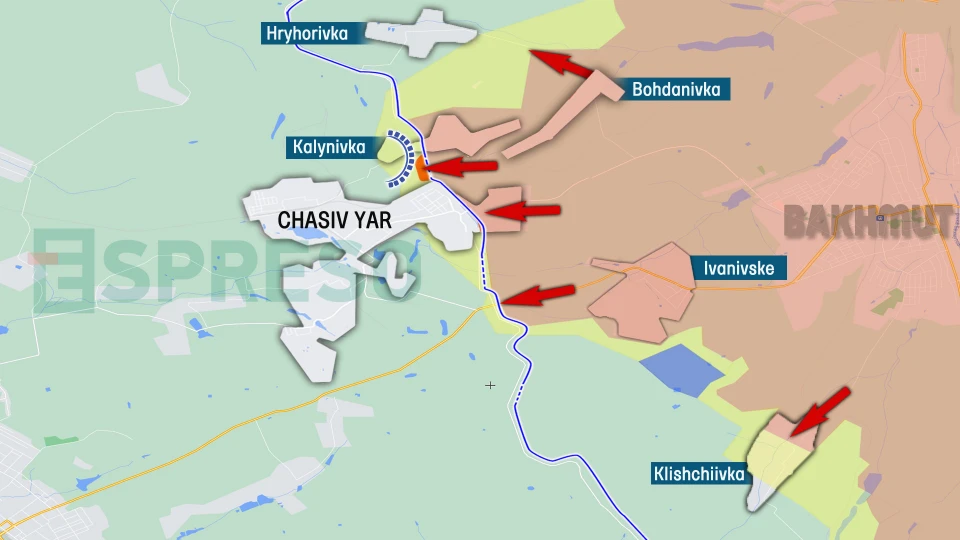
Harsh details of war: battle for Chasiv Yar. Serhiy Zgurets' column
On August 4, reports emerged that Russian forces had allegedly crossed the Siverskyi Donets-Donbas canal. Ukrainian military reported on the situation in one of the frontline areas where fierce fighting continues
First F-16s in Ukraine
The F-16 fighter jets are now officially in Ukraine. On August 4, during the celebrations marking the 20th anniversary of the Ukrainian Air Force, President Volodymyr Zelenskyy officially demonstrated these fighters. This significant development, which has been pursued for nearly two years, marks a major milestone. Currently, there are 10 F-16 fighters in Ukraine.
According to The Economist, an additional 10 F-16s are expected to arrive by the end of this year. In total, Ukraine is set to receive approximately 80 F-16s in the MLU (Mid-Life Update) version. This modernization version includes aircraft that have already been transferred to a European center for operation in Romania to train Ukrainian pilots.
The Netherlands, Denmark, Norway, and Belgium will supply the aircraft, while weapons will be provided by the United States from its stockpile or funded by European countries ordering weapons for our F-16 fighters.
Previously, there were concerns that receiving just 10 aircraft might not be sufficient. However, this marks the first step toward a new quality level and re-equipping with NATO aircraft. The F-16 is a multifunctional platform designed to carry out air missions targeting both land and sea objectives.
This initial step will require Ukrainian military to develop effective tactics, master the weapons, and implement defense strategies. It is a challenging task, and while losses are expected, Ukraine anticipates that this aircraft will lead to greater victories.
Attack on Morozovsk airfield in Russia
Russian aircraft must be neutralized not only in the sky but also on the ground. This was demonstrated by experts of the Defense Intelligence of Ukraine, who provided satellite images showing the destruction of Russian Su-34 bombers at the Morozovsk airfield.
The images confirm that one aircraft was definitely destroyed, and two others sustained significant damage. Additionally, the images indicate that storage facilities containing aircraft munitions were flattened and that the runway was damaged. This marks the unique and effective work of Ukrainian drones. We hope this trend will continue.
Russia continues to use North Korean missiles against Ukraine
Russia is again using North Korean weapons. Evidence shows that Russia used a North Korean KN-23 missile on July 31. Analysis of the debris confirms it is from a KN-23 missile, consistent with previously found debris in Ukraine.
Russia last used North Korean missiles on February 27 this year, launching approximately 50 missiles in total. Half of these missiles exploded in the air. The wreckage of the most recent missile was found in the Kyiv region. Although the missile was aimed at Bila Tserkva, it exploded in the air before reaching its target.
The KN-23 missile has a range of about 600 km and carries a powerful warhead weighing up to 1000 kg TNT equivalent. This shows that Russia is using all available means. Consequently, there is an increased need to activate and expand our air defense systems, which is currently underway.
Situation in one of most challenging sectors: Chasiv Yar
On August 4, reports emerged that Russia had allegedly crossed the Siverskyi Donets-Donbas canal.

Oleksiy Tarasenko, the deputy commander of the 2nd Assault Battalion of the 5th Brigade in the Bakhmut sector, stated that the brigade is holding the line south of Chasiv Yar, where Russia has not yet reached the Siverskyi Donets Canal.
"To the north, where Russia has approached the Siverskyi Donets-Donbas Canal, we are confident that our units are well entrenched and have taken up favorable positions to hold the line. The front line is relatively stable now, and in recent weeks, there has been no advance by Russian forces, not even by 100 meters.
The officer explained that the Siverskyi Donets Canal is a vast anti-tank ditch with concrete and earthen banks, 20 meters wide in some places. Therefore, it is quite difficult for a person without equipment to cross. This requires significant training and also limits the use of equipment, making it a serious obstacle.
The deputy commander noted that Russia attacks continuously. Today, there are numerous Russian movements in the plantations, which are quite chaotic. It seems that Russian groups sometimes lose their way and end up in unintended locations. Nevertheless, Russian troops are operating in small groups of 2-4 people both day and night, trying to advance through the plantations, forested areas, and the canal zone. The Russian army considers every 20-30 meters of such advancement a significant success, so it persists in their small-group operations daily.
Tarasenko emphasized that Russia understands it is easier for a small group to remain unnoticed due to the constant aerial reconnaissance over every square meter of the territory. To counter this, numerous small observation positions are established to cover a large area and to ensure that the defense is layered. This approach prevents the situation where the Russian forces bypass the first position and find no defenders further in. Consequently, Ukrainian defenders have developed quite effective countermeasures.



- News









































